By Ileana Selejan & Thomas Willis
On the night of Saturday March 12th at Casablanc Boston, artist Thomas Willis conducted a performance posed as a completely operational nightclub, showcasing work created during his 2015 summer residency at the Cosmopolitan of Las Vegas. “Retrofit Painting Boston Release Party featuring DJ Wigzen presented by Casablanc and Bombay Sapphire” was, as the tell-all title hints, a painting exhibition topped with an alcohol sponsor, a live dj, as well as a bouncer, two fog machines, and infinite lasers. Willis invited Ileana Selejan to collaborate on the project, and to produce a text -- which, the writer pondered, ought to be site-specific, so as to reflect the identity of this bomba(y)stic installation. Instead of a typical placement on a gallery wall, the text lived on the floor, the dance floor in this case, as an inconspicuous flyer typical to the Las Vegas Strip. This collaborative object between Willis and Selejan was an integral part of the show, offering conceptual insight to the party, while constantly being undermined and eroded by the dancers and fallen gin and tonics of the night.
Now that the hangovers and hanging of the art has subsided, Thomas and Ileana grab a burrito, at a lunch place right outside of Wellesley College’s woodsy campus, to follow up on the performance and creation of the work.
Ileana Selejan: I remember the first time we met, here at Wellesley, because of some photo-meets-campus-related matters. You told me you were an artist. I thought “Oh Wow Yay Bingo,” as I’m always on the look-out for co-conspirators. I asked about your work and things got rapidly confused: you mentioned you were making objects out of canvases, something about a Youtube channel, and that people you were working with, some of whom were my co-workers as well, were cast in those video tutorials and advertisements… and you were laughing the entire time! “Is he serious? Is this an elaborate joke?” Gradually I got to understand what this gigantic yet incredibly detail-oriented project was all about, and which were the component parts.
So, let’s break it down once more. How did it all start? Tell me about The Origins of Retrofit, in short. Not your elevator pitch!
Thomas Willis: But I love elevators! Origins, hmm, okay... Sometimes I enjoy painting pictures of things, and sometimes I get frustrated with painting pictures of things. I think this is how Retrofit Painting started. I don’t mean “painting” strictly as a medium, but painting as a historical and human act: of composing something, objectifying it with parameters, and propagating it as an image -- semiotics right? I started some of this work around 2010, with what you mentioned: taking the traditional art form -- a stretched canvas -- and modifying it to give it a different physical purpose. A painting can be a bed! … Let’s sleep in it! … A painting can be a kite! … Let’s launch it in the air and fly that shit!
IS: [Laughs] Or leave it face down on the earth to see what kind of weeds will grow out the back of it?!

Planter. New Art Center, Newton, Massachusetts. 2013. Thomas Willis.
TW: Yes sir! The paintings never really worked well at fully being any of those things, but for me it was about possibilities and failures in relation to image-based art. After documenting the work and sharing it online, I realized the objects and performances still relied heavily on the branding of the documented images to be seen and understood. I guess that part is sort of obvious for all visual art, but with a majority of the work being viewed on Instagram and Facebook, this infinite dependence on the image is what really fascinated me.
IS: Like a house of mirrors, except you never really know where you’re at…
TW: Yes, unless you have a selfie stick with you. Around this time (2013) I allowed my practice to self-cannibalize, and Retrofit Painting was born! I machine fabricated and hand-crafted a collection of objects, then I created the brand to market the designs, hired models and actors to depict the interaction with the objects, made advertisements to sell them, and presented the work through art-residencies-turned-boutiques; one was at the deCordova Sculpture Park and Museum, and the other at the Cosmopolitan of Las Vegas. I even launched an entire online campaign for the company.

Advertisement for Retrofit Painting. 2015. Thomas Willis.
IS: I’m interested in the anthropological angle here. Because there’s something very “honest” about your work -- I know, don’t wanna put you on the spot, no serious contemporary artist wants to be called THAT but I’m pressing those buttons deliberately.
TW: How so?
IS: By honesty I mean that there’s a sense of connectedness that’s sought, or of relatability. It seems to me that in your work you’re seeking to level with both a wider visual context and a wider audience, which is also made up of lots of ordinary people. You’re not addressing the art world, exclusively; rather you’re trying to shake off some of that exclusivity. Sometimes I wonder if the art crowd is even necessary, although yeah, you don’t want to leave anyone out. Remember the people who came to the event thinking this was indeed, as advertised, a club party, and not an art event, and dressed accordingly sexy for the night-club occasion?
TW: The ones that took over the free photo booth AND dried up the open bar?
IS: Whatever, they looked good! So you had both the artists, and the hipsters, and the party-people, a very diverse, and interesting crowd. And they had a blast.
To return to the anthropological angle, that level of engagement, which is contextual, and site-specific, and depends so much on circumstance and even chance, while at the same time being deeply observant of these rather random social practices we find ourselves embedded in and performing [runs out of breath, breathes]… that to me is very experiential, and experimental. So it’s both anthropological and aesthetic at the same time, even when you’re not quite sure where one begins and one ends.
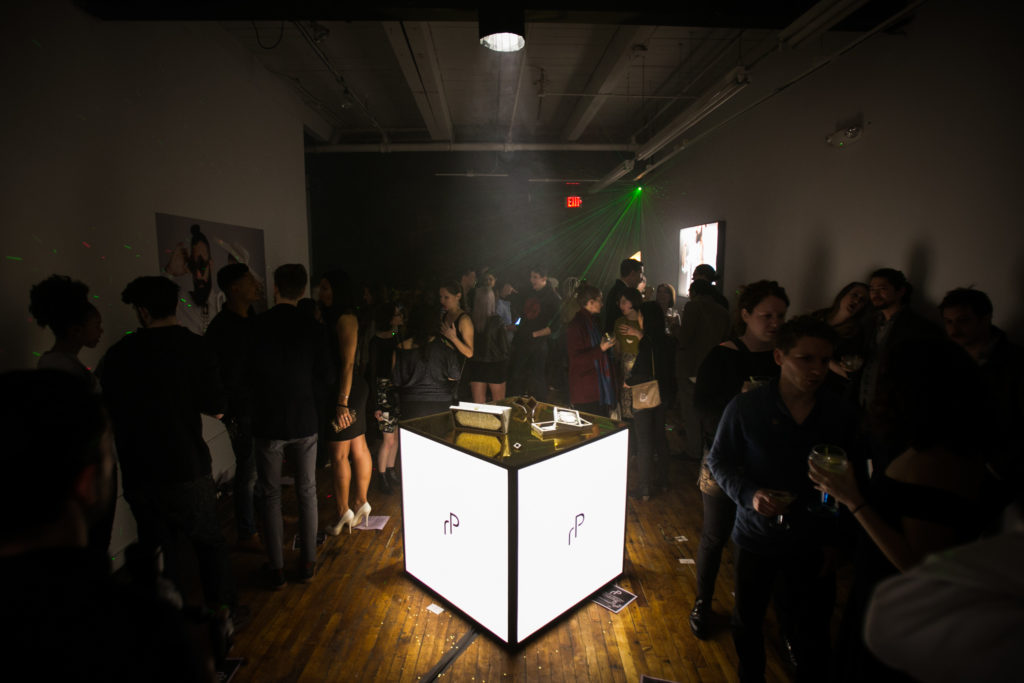
Retrofit Painting Boston Release Party featuring DJ Wigzen Presented by Bombay Sapphire and Casablanc. March 2016. Thomas Willis. Photo by Lauren Termini.
TW: You are absolutely right. The event was intended to be this literal bumping and grinding of worlds, where you have the art people coming for the gallery and objects, the club-goers coming for the dj and open-bar, and together it becomes a sort-of momentous exchange. It is where the facade and the frolic meet, and in this way it was very much about Las Vegas for me.
IS: So, you were born in Vegas, screaming “Viva” at the top of your lungs (clearly). Grew up there, spent most of your young adult years there -- this is a bit of a coming of age story for you, no?
TW: You’d be surprised, I meet so many people who don’t know that there’s real people living there, not just Elvis impersonators. It’s almost impossible for them to comprehend life there. These are even people who’ve said they’ve visited Vegas before!
IS: “What happens in Vegas, stay in Vegas,” dude I even knew this growing up in Romania!
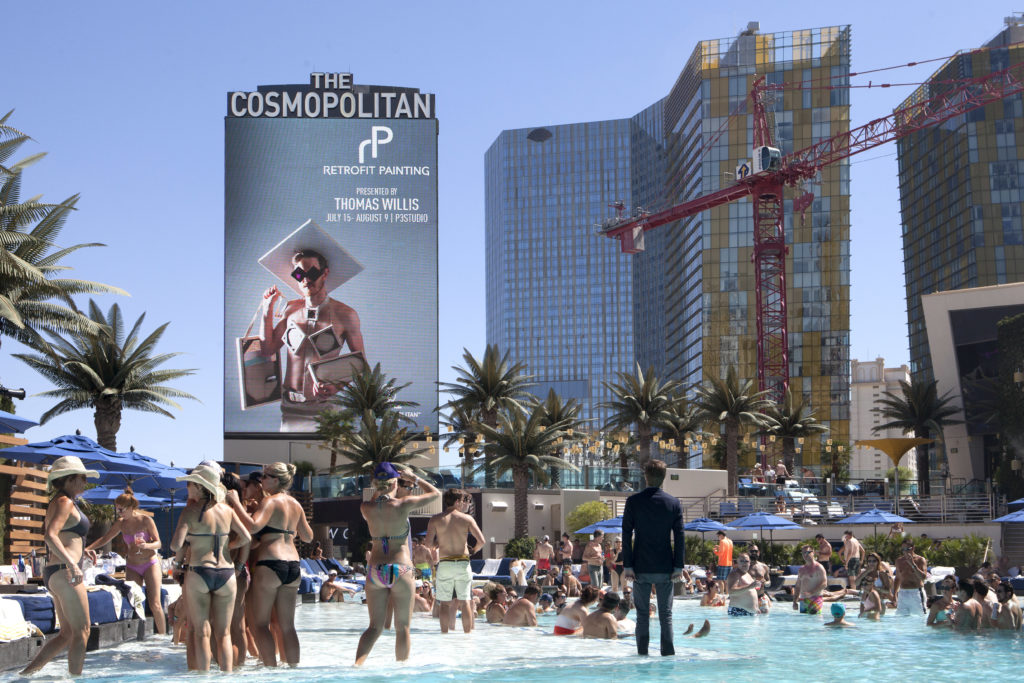
Thomas Willis standing with the Retrofit Painting of Las Vegas sign at Cosmopolitan of Las Vegas on the Las Vegas Strip, summer 2015.
Photo by Mikayla Whitmore.
TW: See! But there was definitely something bizarre about returning home last summer for the Cosmopolitan residency -- after 6 years of living away -- and being put up in a casino suite for over a month with room service, laundry, a 44th floor balcony view, an art studio in the shopping mall, and a hundred foot billboard of myself illuminated on the Strip. Across from Britney Spears! Although not everything was as incredible. I was there for over a month in the hottest part of the summer, I got food poisoning from the casino food, and my hotel lit on fire causing me to exit the 44th floor with a panicking mob of tourists, by flight of stairs!
IS: I was hoping we were going to talk about hangovers, sunburns and aliens… this is actually crazy! Now I’m wondering about the implications of that kind of theatrical backdrop -- the strip, the architecture of the casinos, the glitzy interiors -- how this all impacted the way you look at the world.
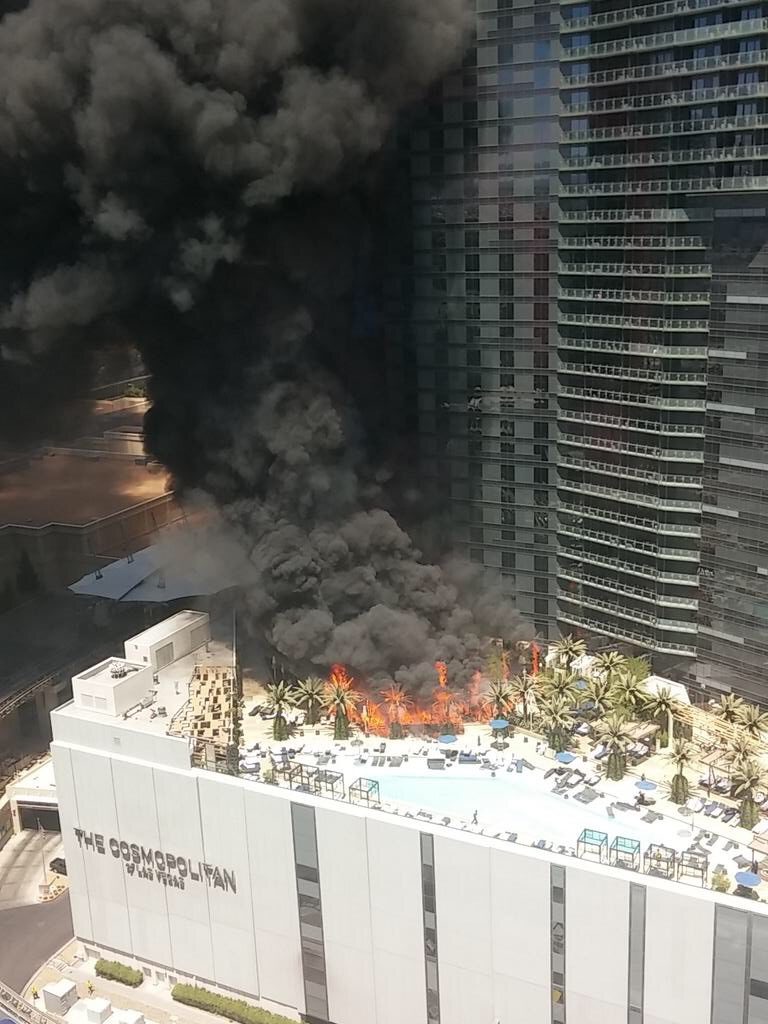
Cosmopolitan of Las Vegas pool fire. July 25, 2015. Photo @ccyr17 Twitter.
TW: Well growing up in Las Vegas was a little bit like growing up in one of those problematic expeditionary photography books from the 1860’s that depicts cultures of the world. Like Disney’s “It’s a Small World,” each building on the Strip compounds a different architectural style from some region on the planet -- fragmenting their history ... It is absurd! The styles are then neatly aligned and conveniently color-coded onto one street called Las Vegas Boulevard -- or onto one plate if you go to the Rio’s Carnival World Buffet...
IS: Sounds like a 24/7 World’s Fair!
TW: The city’s extravagant buildings were what excited me most. As a kid I remember always riding down the I-15 (main interstate that parallels the Strip) and admiring the neon skyline from the passenger window, mainly because I was too small at the time to see the road. I think this forced perspective is what really triggered my appreciation for art.
IS: Funny, the way you’re retelling this memory, it’s as if you were describing the view seen through a camera. That window frame cutting up the cityscape… but maybe that’s my own memories of movies and pictures of Las Vegas, and the romanticisation of its grimy shine.
TW: Definitely, but I think at that age I could only see the shine. The city became a visual toybox of light, color, and form. Although later, while in college, I worked as a green-screen retail photographer on the Strip, capturing thousands of images of tourists as they entered the Shark Reef.
IS: Huh?! Entered the Shark Reeeeef?!
TW: It was a full-sized aquarium attraction of literally sharks in a reef, but really in a desert, you follow? On the greenscreen we would superimpose images of even more deep-sea sharks, and attempt to sell them back to the people for $10.95 upon exit. During my last year in Vegas I hung Damien Hirsts and other macho artworks for the brothers who own Ultimate Fighting Championship. Formative years I tell you.
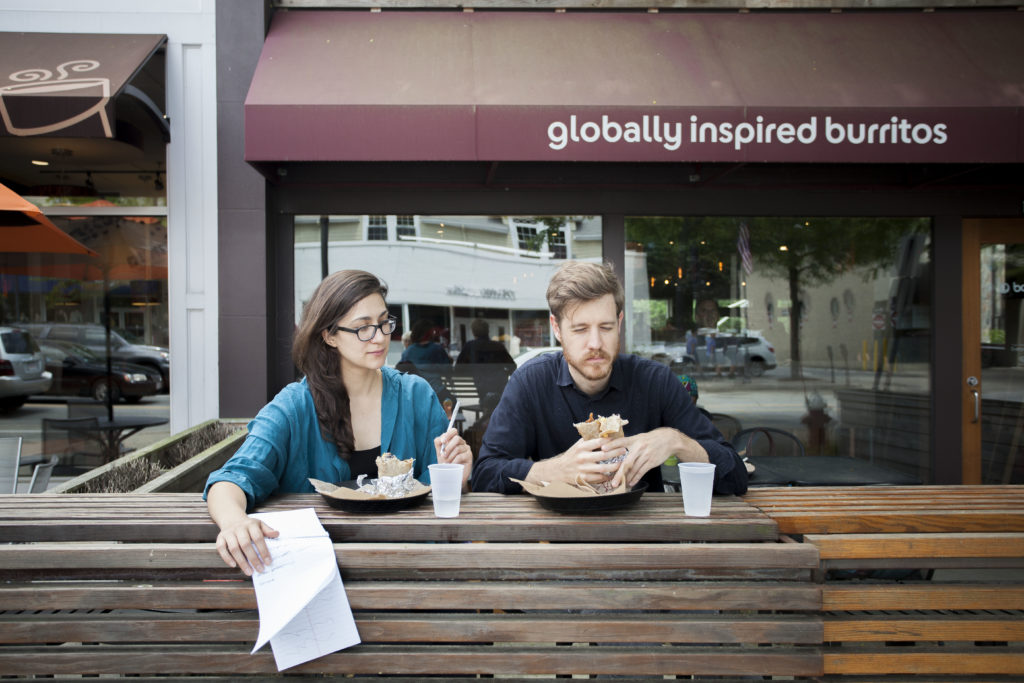
Ileana Selejan and Thomas Willis talking art and eating burritos right outside of Wellesley College. June 2016.
IS: Alright, so I’ve always been curious: what do “normal” people do in Vegas? Where do they hang out? As an artist, is there something specific to that place that you feel has contributed to shaping your work? And I’m talking less about Vegas as subject, more about Vegas as background.
TW: Well the burritos there are way better than Wellesley’s that’s for damn-sure! Vegas is a very young and culturally diverse city, so it’s hard to say anything there is really -- this word makes me squirm -- normal, because Vegas was, and possibly still is, inventing itself.
I guess the one thing we all shared as residents that comes to mind was the style of our houses. Many people in Las Vegas live in street-facing ranch-style stucco homes in community planned neighborhoods, so most of our houses structurally looked the same. I never thought of it this way until now, but these cookie-cutter homes are sort of like blank canvases you buy from art stores -- decorating yours is how you distinguish it from the others.
IS: It occurs to me that as an artist you see several parallel stories running through Vegas -- and my guess would be for other artists from the area as well. Your lives are interconnected with this architecture, while you’re observing “it” from a somewhat detached point of view. Following up on what you mentioned earlier in regards to your childhood, I can imagine that distance growing with the passing of years?
TW: Yes, because Vegas doesn’t have a grand-history like Boston does, the story of the city is still being created by the locals. Moving away and traveling has helped my understanding of Vegas a lot, and where my inspirations are rooted. I’m sure there is even a bit of disconnect and vignetting I do because of the distance, but disconnect is inherent to the city and I’m okay with that.
IS: Do you think you’re cultivating that sort of awareness here in Boston?
TW: I think so, it’s turning out that way. Although we’re working so much here that I feel like we’re still a bit near-sighted to whole thing. Do you agree?
IS: Well I moved here about two years ago, and I still feel like I’m getting to know the place. It definitely has to do with being busy overall, but also age. Boston may be the kind of city that needs a bit of time to reveal itself, although it has lots to offer in terms of art and culture. So a visual landscape like the one in Vegas, which is so overwhelming, and colonizing, how does it flow into the normalcy of everyday life?
TW: Everything seemed pretty normal to me until I moved away. As for local residents, many do work on the Las Vegas strip -- remember what they’re telling us about the Wynn Casino coming to Boston, that it’s great for jobs right?... But many of the locals don’t hang out on the Strip unless it’s for entertainment.
IS: There’s a strong connection to this place that is both formal (to give just one example, your pastiche of commercial design aesthetics) and conceptual (marketing strategies, consumer culture, the entertainment industry, mass tourism, etc.). And this last return you had, your summer residency at the Cosmopolitan, managed to bring together a lot of these influences… which materialized into the latest and to date most polished version of the Retrofit brand.
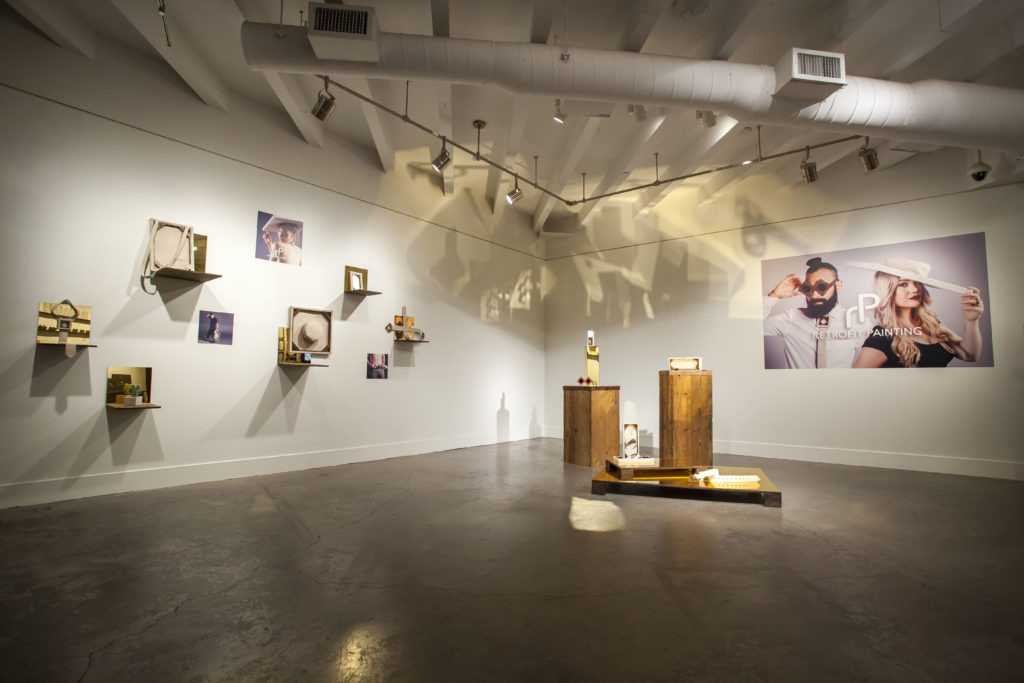
Retrofit Painting of Las Vegas interior boutique at the Cosmopolitan of Las Vegas. Summer 2015. Thomas Willis.
TW: Yes, the latest Retrofit Painting brand is definitely a cumulation of my interests and skills developed between then and now. Whenever I return home to visit I notice a few of the resorts have been remodeled, rebranded, or even destroyed to keep pace with the current trends. Buildings that I identified as permanent city landmarks were merely rotating window displays for the casino developers to swap out.
IS: Sounds mesmerizing, although this kind of horror vacui -- do you think they’d consider covering up the sky in ads if they could? -- topped by the constant consumption, and the crowds... I’d be totally overwhelmed.
TW: That would be so beautiful. I found that branding Retrofit Painting to fit current trends in art and design didn’t seem so farfetched. Also here in Boston I’m exposed to a lot of DIY startup companies and boutiques, and I didn’t see why I couldn’t use this trending business model as a reclamation of this practice. And although Las Vegas holds a lot of problematic and complicated systems in place (gaming, employment, sexual objectification, material and environmental consumption, etc.) many Las Vegas residents don’t have the choice to deviate from these establishments and leave them inoperable, nor do the casino employers provide the education or space for one to take the initiative to change things.
It’s almost like the murphy-painting I slept in for 8 months here in Boston -- there is an entanglement, a balance, and a rest between the surface we see, and the surface we actually live. So that’s exactly what Retrofit Painting attempts to package and sell to the consumers of Las Vegas -- whether it be the living surface of the painting, the depth of the picture plane, the fluid boundaries of the brand, or the more candid and inhabited side of the Vegas facade (in the case of the Cosmopolitan).

Video still from Murphy Painting Nights. 2013. Thomas Willis.
IS: But doesn’t the branding of this relationship end up killing it? Think about the emergence of Pop Art in the late 50s and 60s, how much was it embracing the aesthetic of consumption while seeking to subvert it at the same time?
TW: That’s what I find so layered and confounding! There is clearly a history to that. But I’m more interested in the commodification of niche cultures, in this case something that immediately signals “art market” -- there’s of course a major class aspect to be considered here as well. Take Whole Foods for example -- is it creating a new interest in healthier eating habits for Americans or are they just making natural foods even more expensive and exclusive? I find this niche branding all very nuanced and complicated, and I believe it can be applied to art and how we see, disseminate, and integrate images. How I imagine it, the Retrofit Painting brand is the Whole Foods model for conceptual art.
IS: So, you’re saying there’s a lot more at stake than apparent, both from a social standpoint, and politically? Do you expect your audience / client base to “catch on” to that? Is there a catch? Since the politics in your work is mostly implied rather than directly stated, do you care that people see through to those issues? Is the playfulness a subterfuge?
TW: Retrofit Painting’s trick isn’t unique, it is embedded in the history of painting and branding itself -- dating back to the invention of canvas. I find the history of the material to actually be really fascinating and fucked up. As you would know -- because of its massive size and low weight, when canvas first became popular in Italy around the 15th century, it was not only used to create paintings of religious imagery to propagate across the West during Catholic reformation, but the material was also used to create sailcloth for ships to transport branded products and proliferate commerce -- not to mention the shipment of people and warfare for colonial expansion.
IS: There’s definitely been a traditional misunderstanding of art materials like that, but I feel like even the most esthete contemporary artists are just so cognizant and interested in these convoluted histories. So you’d better understand what it is you’re doing, even if that understanding only emerges as part of process, or through making.
TW: Yes, to return to your trick question, the beauty of Las Vegas is that everyone there knows it’s a trick, BUT NO ONE CARES! We’ll eat that shit up and come back for seconds! Give us a visually compressed history and we’ll dance on it AND FLATTEN IT SOME MORE! It’s like the Retrofit Painting nightclub at Casablanc, and your text on the ground…
IS: [Laughs] Yes, totally flat. No one read that stuff, everyone was too busy losing their shit. Excitement and merriment must be prioritized!
TW: But you know what? I saw many people fold up the flyer and take it with them, even if it was in a questionable state. Let’s include it at the end of this.
IS: Hit it!
“when the night falls my lonely heart calls”[1]
standing on the edge of the desert, overlooking the strip
i watch puffy clouds dissolve,
final strokes of daylight folding into the dusk.
the city awakes, flickering in the dissipated heat
there hasn’t been, nor will there ever be,
a more believable mirage
Utopia for the senses, cornucopia of smiles, lies, and pies (?) Las Vegas has fascinated artists for decades, drawing them in with voracious crowds of regulars, and newbies alike. This is not a place for the socially anxious, or, maybe it could help heal precisely those, through its many initiation rites. Roll your dice. Some compare it to paradise, others to hell. Rumor has it Tom Waits hates Vegas more than Disneyland -- although, even he would have to admit, if there ever was a competition for decadence, this city would certainly win. Who knows what Baudelaire would have thought, as affected as he was, deeply seated in dark mélancolie. Venice of the desert, kingdom of desire, strewn with towering monuments dedicated to consumerism and fate: everyone's life can make a sudden turn, right here, right now. When the occasional bomb was dropped in the desert closeby, tourists could rent rooms in hotels that guaranteed panoramic views of the mushroom cloud. They'd sell Atomic cocktails at the bar -- what better way to contemplate the future that just passed? Once upon a time this place became Las Vegas, "the meadows," named by a Mexican traveler on his mid-day hike. Now there's spotlights and lasers crisscrossing the sky eternally. This city full of sighs, what a cacophony of sounds! Like a pulse that people scream into at the top of their lungs. Dry gusts of wind carried it all away, romantically, into the desert. There's clearly some glam fabulousness to all that, a fearlessness, except we don't see it as high culture. It's a grand performance, one of the most elaborate of all, attitude attitude attitude.
"As an artist I can take these chances, make something absurd like this" Willis tells me in the throbbing disco lights, as we talk about painting and play, risks, and the possibilities therein. Painting, one of the oldest, and in many ways most traditional of mediums -- what can it do for us? How can we put to use the language, the technical means, the surfaces, in our most immediate lives? Once you apply the filter of the vernacular, everything can be turned into canvas, everything that isn't one already, that is.
"Casablanc and Bombay Sapphire present: Retrofit Painting Boston Release Party featuring DJ Wigzen" is Thomas Willis' latest project, a relational performance, taking as its point of departure a summer residency turned storefront exhibition that the artist organized at the Cosmopolitan in Las Vegas. Retrofit Painting is more than a brand, he claims. It must be true; why else would anyone spend so many hours on making such carefully-crafted wonderfully dysfunctional things? We should take him up on it, cultivate our sense of the bizarre, live a bit more Surrealistically. Take advantage of the opportunities that are right in front of our eyes. Less therapy, more dance floor action. Disco queens, "put on your red shoes and dance the blues," as it goes. By tomorrow, all will have vanished like a mirage...
[1] Whitney Houston, “I Wanna Dance with Somebody (Who Loves Me),” Whitney, Arista, 1987.
Ileana L. Selejan is the Linda Wyatt Gruber ’66 Curatorial Fellow in Photography, at The Davis Museum at Wellesley College. She received her PhD in Art History from the Institute of Fine Arts, New York University. Her work focuses on war and documentary practices, and the intersection of aesthetics, ethics, and protest in photography and art. Ileana also writes independently, and is a contributing member of kinema ikon.
Thomas Willis is a Boston-based artist originally from Las Vegas, NV. Willis received his BFA in painting and drawing from the University of Nevada, Las Vegas in 2009. He has exhibited across the United States, with works in institutions such as the Luo Ruvo Center for Brain Health, Bentley University, deCordova Museum, and the Cosmopolitan of Las Vegas. Willis currently works for the Art Department at Wellesley College and has a studio at the Dorchester Art Project in the neighborhood of Field’s Corner, Boston.
Further information on Willis’ project can be found on the artist’s website www.thomaswillis.net, or at www.retrofitpainting.com

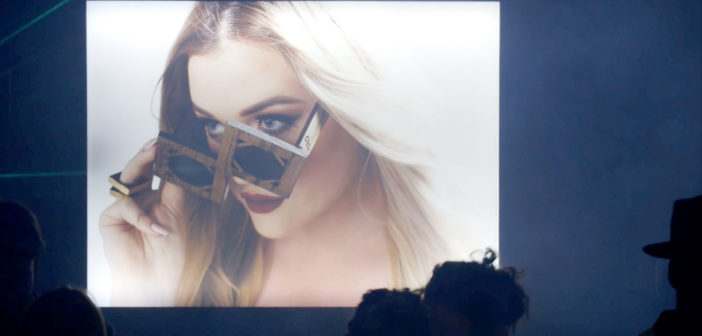
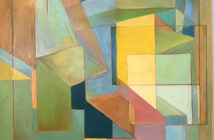

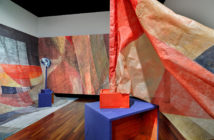
1 Comment
Pingback: Settlers and Nomads July 2016 Exhibitions, Events and News - Settlers and Nomads